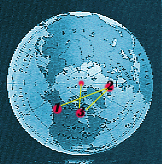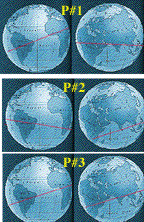 Looking down on the current North Pole, we can identify
at least 3 previous positions of the pole, according to Hapgood.
These are shown roughly by the numbered red dots below. (The exact
locations were given on the previous page)
In his revised version, the movements to each of these
positions were not cataclymically fast, but relatively slow. Each
took about 5000 years. According to his interpretation of the
evidence, after each shift the new north pole remained in place for
between 20 and 30 thousand years.
Looking down on the current North Pole, we can identify
at least 3 previous positions of the pole, according to Hapgood.
These are shown roughly by the numbered red dots below. (The exact
locations were given on the previous page)
In his revised version, the movements to each of these
positions were not cataclymically fast, but relatively slow. Each
took about 5000 years. According to his interpretation of the
evidence, after each shift the new north pole remained in place for
between 20 and 30 thousand years.
 Position #1 -- From the Yukon area of North America at
about 80, 000 B.P. and moving east by 75,000 B.P to the Greenland
Sea.
Position #2 -- From the Greenland Sea, starting at
about 55,000 B.P. and then moving south-west by 50,000 B.P. towards
what is now Hudson Bay.
Position #3 -- From the Hudson Bay area at about 17,000
P.P. and moving north to its present location by about 12,000
B.P.
If the poles shift even as little (within 40 degrees)
as Hapgood argues, then the equator moves in significant ways. This
is shown below by the red lines on the paired views of the globe).
Each pair shows two views of where the equator would be, roughly, for
each position of the north pole shown above.
The changes in position are especially noticable by
where the equator cuts across the African continent in each
situation--high, diagonally or low, compared to today.
Position #1 -- From the Yukon area of North America at
about 80, 000 B.P. and moving east by 75,000 B.P to the Greenland
Sea.
Position #2 -- From the Greenland Sea, starting at
about 55,000 B.P. and then moving south-west by 50,000 B.P. towards
what is now Hudson Bay.
Position #3 -- From the Hudson Bay area at about 17,000
P.P. and moving north to its present location by about 12,000
B.P.
If the poles shift even as little (within 40 degrees)
as Hapgood argues, then the equator moves in significant ways. This
is shown below by the red lines on the paired views of the globe).
Each pair shows two views of where the equator would be, roughly, for
each position of the north pole shown above.
The changes in position are especially noticable by
where the equator cuts across the African continent in each
situation--high, diagonally or low, compared to today.
 Go to the next page for a closer view of each pair.
Continue
| Back to
Hapwood | Evidence_Chart | Technical_Argument
Basic
Ideas | Topics List
Go to the next page for a closer view of each pair.
Continue
| Back to
Hapwood | Evidence_Chart | Technical_Argument
Basic
Ideas | Topics List



